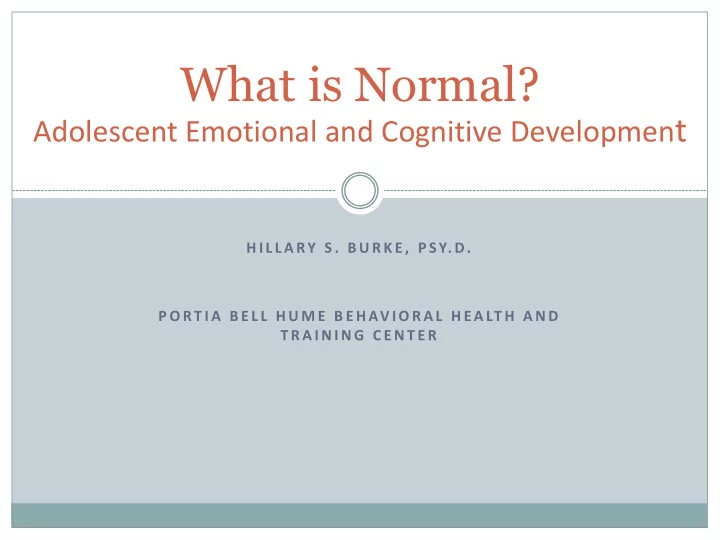

What is Normal? Adolescent Emotional and Cognitive Developmen t H I L L A RY S . B U R K E , P SY. D. P O RT I A B E L L H U M E B E H AV I O R A L H EA LT H A N D T R A I N I N G C E N T E R
Background Education and Training The Hume Center School Based Program
Frontline: Inside the Teenage Brain What is http://www.pbs.org/wgbh/pages/frontline/video/flv/generic.html ?s=frol02sfa8q392&continuous=1 Normal?
Common Teen Characteristics Often erratic and inconsistent in their behavior Have chemical and hormonal imbalances which often trigger emotions that are frightening and poorly understood Are easily offended and are sensitive to criticism
Common Teen Characteristics Tend to exaggerate simple occurrences and believe that personal problems, experiences, and feelings are unique to themselves Are moody, restless Often feel self-conscious and alienated Can lack self esteem
Common Teen Characteristics Have emerging sense of humor Are psychologically at- risk
Common Teen Characteristics Searching for adult identity and acceptance › even in the midst of intense peer group relationships Are vulnerable to naive opinions, one-sided arguments Are searching to form a conscious sense of individual uniqueness › "Who am I?"
Identity Emotional development during adolescence involves establishing a realistic and coherent sense of identity
Establishing a Sense of Identity traditionally thought of as the central task of adolescence (Erikson, 1968) Adolescence is the first time when individuals have the cognitive capacity to consciously sort through who they are and what makes them unique Identity refers to how adolescents see themselves right now also includes what has been termed the “possible self”
Identity Includes Two Concepts Self Concept 1. Self-Esteem 2.
Two Identity Concepts Defined Self-concept › the set of beliefs one has about oneself. Self-esteem › Involves evaluating how one feels about one’s self -concept. › Self-esteem develops uniquely for each adolescent
Self Concept Emotional Development of Adolescents: Identity http://study.com/academy/lesson/aspects-of-the-social-development-of-adolescents.html?scrlybrkr
Influences on Identity Physical changes Comments by others Reflect appraisals of the individual that some adolescents may incorporate as part of their identity and feelings about themselves (Robinson, 1995)
Identity Experimentation Experimenting with different ways of appearing, sounding, and behaving Adolescents who fail to experiment in any realm are sometimes seen to be more stable but may, in fact, be experiencing more difficulty than youth who seem to shift from one interest to another.
Emotional Intelligence Emotional skills necessary to manage stress and be sensitive and effective in relating to other people. These skills have been called “emotional intelligence” (Goleman, 1994).
Emotional Intelligence Self-awareness Relationship skills › the ability to get along well with other people and to make friends.
Emotional Intelligence
Emotional Intelligence Recognizing and managing emotions Developing empathy
Emotional Intelligence Important skills to begin to master as part of emotional development Recognizing and managing emotions › In order to label their feelings accurately, adolescents must learn to pay conscious attention to them. › Being aware of and being able to label their feelings helps them be able to identify options and to do something constructive about them.
Emotional Intelligence Developing empathy Recognizing their own emotions lays the groundwork but does not ensure that youth will recognize that others have feelings and that they need to take these feelings into account.
Support Strategies for You and Your Teen Use non-threatening questions › Choosing only one or two questions at a given time, ask questions that help them to define their identities. Who do you admire? What is it about that person that makes them admirable? What do you like to do in your free time? What do you consider to be your strengths? What are your hopes for the future? What have you done in your life that you feel proud of (even if just a little)? Listen nonjudgmentally › listen more than you speak
Support Strategies for You and Your Teen Ask open-ended questions Avoid “why” questions › Try to rephrase your questions to get at what they were thinking rather than the reason for something. › For example, instead of asking, “Why did you say that?” say instead: “You seemed to be really trying to get across a point when you did that. Can you tell me more about what you meant?”
Support Strategies for You and Your Teen Acknowledge the adolescent’s emotional state › Reflecting someone’s mood helps the individual feel understood ( Forgatch & Patterson, 1989). Model rational decision-making strategies. › Discuss how you once arrived at a decision. › Briefly (attention span!) explain how you (or someone you know well): defined the problem generated options anticipated positive and negative consequences made the decision evaluated the outcome
Support Strategies for You and Your Teen Discuss ethical and moral problems that are in the news › Encourage them to think through the issues out loud. › Without challenging his or her point of view, wonder aloud about how others might differ in their perspective on the issue and what might influence these differences (Santilli & Hudson, 1992).
Support Strategies: Agreements Contracts Clear expectations Rewards and Consequences You can always refer back to the contract if the rule/behavior continues.
Strategies: Healthy Lifestyle Sleep › Research indicates that teens need 9 ¼ hours of sleep each night. › Deep sleep coincides with the release of growth hormone in children and young adults. › REM sleep stimulates the brain regions used in learning. › Sleep appears necessary for nervous system to function properly.
Strategies: Unhealthy Lifestyle Lack of Sleep › Limits ability to learn, listen, concentrate and solve problems. › Leads to impaired memory and physical performance. › May lead to aggressive or inappropriate behavior. › May be related to unhealthy habits: overeating, use of nicotine and caffeine. › Can contribute to increased incidence of illness. › Contributes to acne and other skin problems.
References https://www.apa.org/pi/families/re 1. sources/develop.pdf http://pubs.cde.ca.gov/tcsii/docum 2. entlibrary/characteristicsmg.aspx https://tip.duke.edu/node/1640 3. https://www.amle.org/BrowsebyTo 4. pic/WhatsNew/WNDet/TabId/270/ ArtMID/888/ArticleID/455/Develop mental-Characteristics-of-Young- Adolescents.aspx http://www.pbs.org/wgbh/pages/fr 5. ontline/shows/teenbrain/view/?scrl ybrkr
Recommend
More recommend